Assertion (A) Hydrolysis of (-)-2-bromooctane proceeds with inversion of configuration
Reason (R) This reaction proceeds through the formation of a carbocation.
Assertion and reason both are correct and reason is correct explanation of assertion
Assertion and reason both are wrong statements
Assertion is correct but reason is wrong statement
Assertion is wrong but reason is correct statement.
The correct Answer is:C
To solve the question, we need to analyze both the assertion and the reason provided.
Step 1: Understand the Assertion
The assertion states that the hydrolysis of (-)-2-bromooctane proceeds with inversion of configuration.
- Explanation: In an SN2 reaction, the nucleophile (OH⁻ in this case) attacks the carbon atom that is bonded to the leaving group (Br) from the opposite side. This back-side attack leads to the inversion of configuration at the carbon center. Since (-)-2-bromooctane is a chiral molecule, the inversion of configuration means that the product will have the opposite configuration compared to the starting material.
Step 2: Analyze the Reason
The reason states that this reaction proceeds through the formation of a carbocation.
- Explanation: In SN2 reactions, there is no formation of a carbocation. Instead, the nucleophile attacks the substrate directly, leading to a concerted mechanism where the bond to the leaving group breaks as the bond to the nucleophile forms. Carbocation formation is characteristic of SN1 reactions, not SN2.
Step 3: Conclusion
- The assertion is true: Hydrolysis of (-)-2-bromooctane does proceed with inversion of configuration.
- The reason is false: This reaction does not proceed through the formation of a carbocation; it is an SN2 mechanism.
Final Answer
The assertion is correct, but the reason is incorrect.
---
The assertion states that the hydrolysis of (-)-2-bromooctane proceeds with inversion of configuration.
The reason states that this reaction proceeds through the formation of a carbocation.
- The assertion is true: Hydrolysis of (-)-2-bromooctane does proceed with inversion of configuration.
- The reason is false: This reaction does not proceed through the formation of a carbocation; it is an SN2 mechanism.
The assertion is correct, but the reason is incorrect.
Topper's Solved these Questions
- HALOALKANES AND HALOARENESBOOK - NCERT EXEMPLAR ENGLISHCHAPTER - HALOALKANES AND HALOARENESEXERCISE - Long Answer Type Questions
3 Videos
- HALOALKANES AND HALOARENESBOOK - NCERT EXEMPLAR ENGLISHCHAPTER - HALOALKANES AND HALOARENESEXERCISE - Match Type Questions
6 Videos
- GENERAL PRINCIPLE AND PROCESSES OF ISOLATION OF ELEMENTS BOOK - NCERT EXEMPLAR ENGLISHCHAPTER - GENERAL PRINCIPLE AND PROCESSES OF ISOLATION OF ELEMENTS EXERCISE - Long Answer Type Questions
1 Videos
- P-BLOCK ELEMENTSBOOK - NCERT EXEMPLAR ENGLISHCHAPTER - P-BLOCK ELEMENTSEXERCISE - Long Answer Type Questions
3 Videos
Similar Questions
Knowledge Check
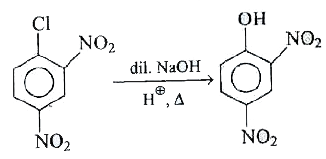 , this reaction proceed through : Aelectrophilic additionBbenzyne intermediateCnucleophilic aromatic substitutionDoxirane
, this reaction proceed through : Aelectrophilic additionBbenzyne intermediateCnucleophilic aromatic substitutionDoxiraneAn SN2 reaction occurs through the formation of a
AcarbocationBcarbanionCfree radicalDtransition state.Which of the following reactions proceeds with retention of configuration ?
A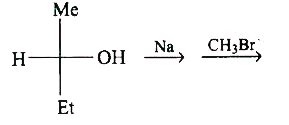 B
B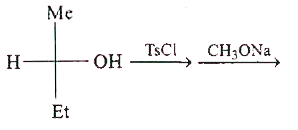 C
C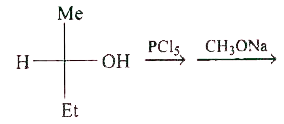 D
D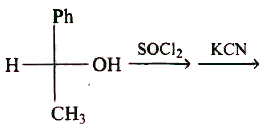

The only CORRECT combination in which the reaction
proceeds through radical mechanism is
View SolutionAliphatic nucleophilic substitution is mainly of two type SN1 and SN2.SN2 reaction proceed with strong nucleophile in polar aprotic solvent. 3∘ halides do not give SN2 reaction. Inverted products are obtained in this reaction and mechanism of reaction occurs through the formation of transition state.
SN1 reaction proceed through the formation of carbocation in polar aprotic solvent. Solvent itself acts as nucleophile in this reaction. Racemization takes place in SN1 reaction.
Which one of the following will give SN2 reaction ?
View SolutionAliphatic nucleophilic substitution is mainly of two type SN1 and SN2.SN2 reaction proceed with strong nucleophile in polar aprotic solvent. 3∘ halides do not give SN2 reaction. Inverted products are obtained in this reaction and mechanism of reaction occurs through the formation of transition state.
SN1 reaction proceed through the formation of carbocation in polar aprotic solvent. Solvent itself acts as nucleophile in this reaction. Racemization takes place in SN1 reaction.
Which of the following compounds will give SN1 reaction?
View SolutionAliphatic nucleophilic substitution is mainly of two type SN1 and SN2.SN2 reaction proceed with strong nucleophile in polar aprotic solvent. 3∘ halides do not give SN2 reaction. Inverted products are obtained in this reaction and mechanism of reaction occurs through the formation of transition state.
SN1 reaction proceed through the formation of carbocation in polar aprotic solvent. Solvent itself acts as nucleophile in this reaction. Racemization takes place in SN1 reaction.
Which one of the following will give racemised product in C2H5OH ?
View SolutionAssertion (A) Addition reaction of water to but-1-ene in acidic medium yields butan-1-ol.
Reason (R) Addition of water in acidic medium proceeds through the formation of primary carbocation.
View Solution

